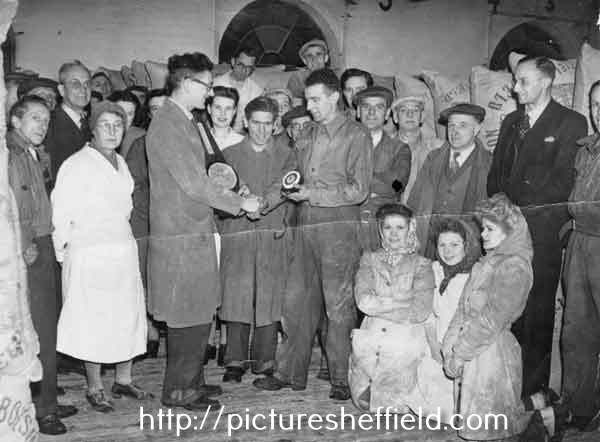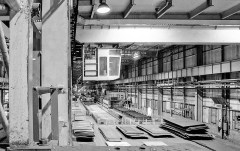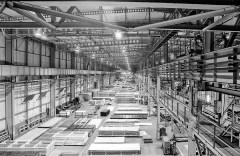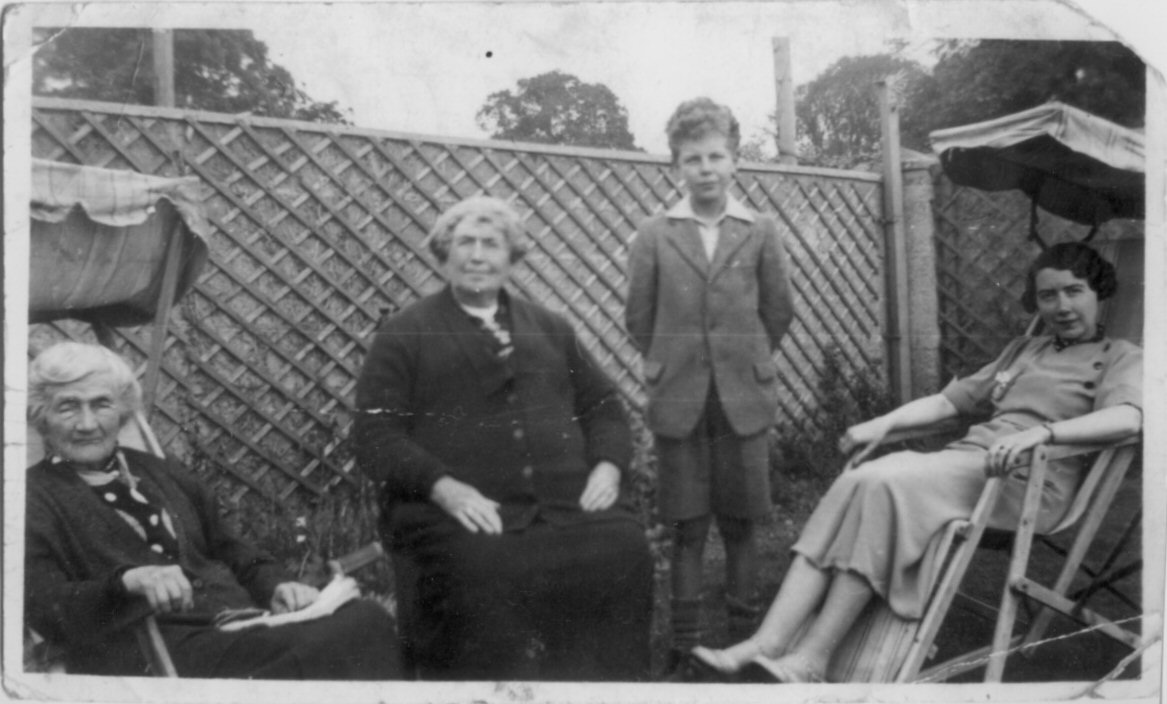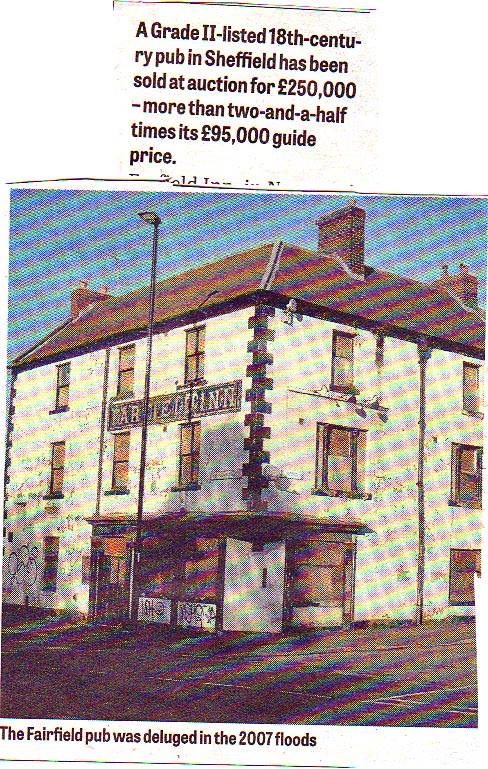Search the Community
Showing results for 'coal pit lane'.
-
Above the building (now Broncos) on the corner of West Street and Carver Lane there is a monogram S1B (?). I am sure that it is blinding obvious but ... please enlighten me. It is the "1" that is throwing me. Thanks
-
My granddad Robert sustained a broken spine as a result of being crushed between a full tub of coal and the pit side of Nunnerley colliery on 14 May 1947. He died in the Sheffield Royal Infirmary on the 16th. The coroner for the City of Sheffield raised an inquest on the 17th. Would anyone know if I can see a copy of this? Also, would grandma have received any compensation? Many thanks, Derek.
-
Shire House, Nether Shiregreen. u01160 1910s05982 u01159 Shire House/ Shire Hall, front view. https://www.picturesheffield.com/frontend.php?keywords=Ref_No_increment;EQUALS;v00806&pos=24&action=zoom&id=42608 See also: Sale of superb furniture and choice stock of wine and other valuable effects of Mr. A.A. Hardy dec Wednesday August 5th 1829 Local Studies Sale Catologues Vol 5 Ref: 017.3 S Shire House, (built by Hugh Mellor about 1810, Shiregreen, Wincobank & Ecclesfield, by Brian Wooodriff) isn't mentioned in the 1825 Directory, but there is Andrew Allen Hardy, solicitor and coroner for West Riding of Yorkshire, 19 Bank Street, Sheffield. He had succeeded John Foster of High Green who'd died 4th October 1822 aged 72 years at the Bull & Mouth, Waingate after being taken ill presiding at an inquest. A. A. Hardy held the post until quite suddenly he left the town, leaving large amount of debts unpaid; it was reported he died at Liverpool 20th June 1829, although it was whispered that he was after that date seen alive in America. Thomas Badger, solicitor of Rotherham with offices in High Street Rotherham and Bank Street, Sheffield followed in the role of Coroner, 20th July 1829 after Mr. Hardy's "death." Thomas Badger held the office of Coroner for the next 33 years. Information from the obituary of Thomas Badger, Rotherham Advertiser 2nd August 1862. From White's Directory of 1833 "Shire Green & Nether Shire are neighbouring hamlets 3 miles north of Sheffield and form another seat of the table fork manufacture." In Nether Shire, situated below Nethershire Lane with an entrance off Bellhouse Road, "Shire House a large and pleasant mansion is now the seat of Richard Greaves of Sheaf Works." OS Map 1850. https://maps.nls.uk/view/102345193#zoom=6&lat=4852&lon=14460&layers=BT Richard Greaves died at Shire House, 26th April 1835 aged 55 and buried in the family tomb, Upper Chapel. William Greaves & Sons, Sheaf Works. https://www.hawleysheffieldknives.com/index.php?val=g&kel=1556 Next recorded occupant, 1849 Directory, Capt. Caper, but in 1852 Directory he is recorded as Capt. Capel, staff officer, Shire House. Was he Captain of a Volunteer Brigade, does anybody know anything about him. 1856 Directory the occupant is Henry Hall, Henry, silver plater, Shire House, Shiregreen & Sheffield; Walker & Hall, electro plater & etc. 11 Howard Street. Henry Hall is recorded as a gent, Shire House, 1862 Whites Directory. Henry Hall (c.1802 - 1889), partner of Walker and Hall Ltd. y11266 Image from Walker and Hall, Electro Works Sheffield pamphlet, c.1900 (Sheffield Local Studies Library: 338.4 SST page 11) Walker & Hall Ltd. https://www.hawleysheffieldknives.com/index.php?val=w&kel=367 Change of occupant by the 1879 Directory, Captain Thomas William Jeffcock J.P. (1839-1900) Shire House. Thomas William Jeffcock JP (1839 - 1900), colliery owner, late of Shire House, below Nether Shire Lane, Shiregreen. y08626 For biographical details see 'Sheffield at the Opening of the 20th Century: Contemporary Biographies', S. O. Addy, 1900 (Local Studies 920.04274 SQ 1901 Directory recording "Shire House now unoccupied." Directory 1905, Shire House now in the occupation of James W Dixon. 1911 Directory he had become Major Jas. Willis Dixon. FRGS. Died 1917. James Dixon & Sons Ltd. https://www.hawleysheffieldknives.com/index.php?val=d&kel=372 Link to: Definitely not Victoria most probably. Carter & Sons Glass Bottle. https://www.sheffieldhistory.co.uk/forums/topic/11371-definitely-not-victorian-most-probably/ 1919 see above Sheffield History Link. Geoffrey Cecil Carter, manufacturing chemist (Carter & Sons), Shire House. Former premises of Carter and Sons Ltd., manufacturing chemists, Attercliffe Road. 1987t08420 https://www.picturesheffield.com/frontend.php?keywords=Ref_No_increment;EQUALS;u08477&pos=3&action=zoom&id=90329 Fire at Carter and Sons, wholesale druggist and manufacturing chemists, Attercliffe Road, Sheffield: advertisement for temporary store (at Savile Street) following the fire at the Attercliffe Road store on 10 Feb 1922. y10022 Original at Sheffield Local Studies Library: MP 1705 VL. Carter and Sons, wholesale druggist and manufacturing chemists, Attercliffe Road: on fire at approx. 9.30 pm 19th Feb 1922. y05297 y10023 Demolition of Shire House. u01158 Who was Hugh Mellor, the builder of Shire House? Was there any other occupants? What was the date of demolition.
-
Steel workers Pub, bottom of Shepcote Lane.
-
The Ringinglow estate, the property of the late Thomas Rawson, 1827] https://www.picturesheffield.com/frontend.php?keywords=Ref_No_increment;EQUALS;arc03946&pos=44&action=zoom&id=101954 Git Mottram: 1. Rough Smeltings and Croft, 2. House and garden, 3. Upper Smeltings, 4. Lower Smeltings. In hand, 5. New planting, 6. Bank plantation, 7 and 8. plantations, 9. Weigh house, 10. Rough plantation toll house and part cultivated, 11. Stack Garth Plantation, 12 - 14. Plantations, 15. Upper Lumb, 16. Lower Lumb, 17. Plantation adjoining Porter Brook. 18. plantation in Angram Lane. Richard Whitworth 19. Ringinglow Inn [later the Norfolk Arms], homestead, out buildings, yard and garden, 20. Stack Garth, 21. House Field, 22. Upper Planting field, 23. Cow Pasture, 24. Lamb Field, 25. Low Rye Field, 26. Rye Field. 27. Horse Pasture, 28. The Rough Banks; James Creswick, 29. Bottoms, 30. Well Bank, 31. Well Field, 32. Middle Common Piece, 33. Four Acre, 34. Barley Field, 35. Wiggin Field, 36. Bennet Field and Calf Croft, 37. Anise Field, 38. Planting Field, 39. Croft, 40. Homestead, house etc., 41. Old Field; Benjamin Fox, 42. Bank., 43. [black], 44. Broomhead Field, 45. Pingle. Thomas Watson, 46. Allotment. Also shows colliery, road from Grindleford Bridge [Sheephill Lane], Ringinglow Road, Barber Fields, road to Fulwood [Fulwood Lane], site of [Norfolk Arms], [toll house], house field, Angram Lane, road to Birks Green and road from Bower Hill [Cottage Lane?].
-

What does "main" mean in a colliery name ?
Edmund replied to JS2021's topic in Sheffield History Chat
It appears that the tradition of naming collieries as "Main" originated in the North East at an early date. The "Main" seam coal was so attractive that even collieries that did not extract coal from the Main seam began to use the name, and "Main" became synonymous with Mine" : -
New Corn Exchange, built early 1880-81, Broad Street, right. s00292 Corn Exchange - built for the Duke of Norfolk in 1881 The Central Hall of the Corn Exchange was gutted by fire in 1947 and the offices surrounding it were demolished in 1964. Engraving of the newly built Corn Exchange, Broad Street, right. s22437 H.W. Brewer (Etcher) u02332 The Shah of Persia [Iran] in England - scene in the Corn Exchange, Sheffield, during the presentation of an address from the Mayor. 1889.y11829 Image from The Graphic, 20 July 1889. Sheffield Local Studies Library: MP 1834 L. Architects drawing for the Old Corn Exchange, Broad Street erected 1830. This design was never built. s41155 Architects design for the old Corn Exchange - 1830 (this was not the adopted design) s01896 The old Shrewsbury Hospital, Castlefolds, founded 1616. The Corn Exchange later stood on this site. 1st January 1819.s07452 E. Blore, Artist Plan of part of the town of Sheffield, comprising the site of the present and proposed corn, hay and cattle markets, also various improvements connected with the latter. 1827. With illustrations of proposed Corn Exchange, elevation of the houses fronting the new Hay Market, and an elevation of the bridge over the Dun [Don]. https://www.picturesheffield.com/frontend.php?keywords=Ref_No_increment;EQUALS;arc04183&pos=14&action=zoom&id=104936 Reference a - Proposed Corn Exchange and office, b - erections on each side of Corn Exchange, c - weighing machine, d - row of shops. Inns in the immediate vicinity of the present Hay and Corn Markets 1 George, 2 King’s Head, 3 Angel, 4 Commercial, 5 Yellow Lion, 6 Tontine, 7 Healeys Hotel. The sites of the present Hay, Corn and Cattle markets are coloured red, and proposed are coloured blue. Other improvements are shown in yellow. Marked are: Market Place, Angel Street, Angel Inn, old Corn Market, King Street, Post Office, Change Alley, Kings Head, Fruit Market, Market Street, Norfolk Street, John Street, Commercial Inn, Hay Market, Yellow Lion, Pond Lane, Shude Hill, Fish Market, Dixon Lane, Tontine Inn, Castle Folds, Castle Hill, Healeys Hotel, Sheaf Bridge, River Sheaf, canal bridge, proposed Hay Market, proposed Corn Market, Broad Street, Canal Basin, Canal Warehouse, Market for fat cattle, lean cattle and milch cows, pig market, sheep market, River Dun [River Don], Willey Street, Blonk Street, Wicker, Cattle Market, Ladys Bridge, Bridge Street, Wain Gate, Town Hall, Killing Shambles and Castle Street. Sheffield Markets. 1847. https://www.picturesheffield.com/frontend.php?keywords=Ref_No_increment;EQUALS;arc04188&pos=16&action=zoom&id=104947 Marked: Old Haymarket, Dixon Lane, Castle Folds, Exchange Street, new market ground, Cheese Market, Corn Exchange, Broad Street. New Corn Exchange - plan showing groups of desks. 28th November 1881. Architects: M E Hadfield and Son, Architects, New Corn Exchange Chambers. https://www.picturesheffield.com/frontend.php?keywords=Ref_No_increment;EQUALS;arc04419&pos=8&action=zoom&id=151747 Corn Exchange - office doors, panels and rails, etc., c.1881? Not dated. https://www.picturesheffield.com/frontend.php?keywords=Ref_No_increment;EQUALS;arc04417&pos=6&action=zoom&id=151745 Corn Exchange - doorway, etc., c.1881? Not dated. https://www.picturesheffield.com/frontend.php?keywords=Ref_No_increment;EQUALS;arc04418&pos=7&action=zoom&id=151746 Maunche Hotel and Corn Exchange, Exchange Place / Wharf Street on Ordnance Survey Map. 1890. https://www.picturesheffield.com/frontend.php?keywords=Ref_No_increment;EQUALS;y06787&pos=3&action=zoom&id=59989
-
Plan of the premises in Arundel Street and Sycamore Street belonging to Parker, Potts and Denton, and of the adjoining premises belonging to James Hibberson, 1827. https://www.picturesheffield.com/frontend.php?keywords=Ref_No_increment;EQUALS;arc04033&pos=1&action=zoom&id=103278 Shows Arundel Street, [Arundel Lane], Sycamore Street, foot road from Pond Street, John Wilson's furnaces, stable, carriers warehouse, counting house, brewhouse, gateway, house, passage, Balloon Tavern, workshops, merchant's warehouse, etc. Note a trade directory of 1829 lists Parker, Potts and Denton as Edge Tool Manufacturers of Arundel Street; and - Hibberson, as a carrier (with carriages to Hull, Liverpool, Manchester and Cheshire) Land sold by Parker, Potts and Denton to their neighbour, James Hibberson. No date. https://www.picturesheffield.com/frontend.php?keywords=Ref_No_increment;EQUALS;arc04034&pos=2&action=zoom&id=103279 Shows Arundel Street, Arundel Lane, Sycamore Street, and Parker, Potts and Denton's premises, comprising cart house (hay loft), stable and workshops. Also shows James Hibberson's new stables. Plan of the freehold premises in [Arundel] Street and Sycamore Street belonging to Parker, Potts and Denton. 1828 https://www.picturesheffield.com/frontend.php?keywords=Ref_No_increment;EQUALS;arc04035&pos=3&action=zoom&id=103280 Shows: Arundel Street, Arundel Lane, Sycamore Street, and Parker, Potts and Denton's premises, comprising cart house (hay loft), stable and workshops. Also shows James Hibberson's property, together with a theatre further up Sycamore Street (at junction with Arundel Street) [?Theatre Royal].
-
William Hibbert (senior) was born in Hartington, Derbyshire in 1806. He was a carver and gilder in Baslow and married Matilda Marples (dressmaker) on 23rd April 1832 at Baslow. He had probably already done a lot of business carving and gilding at Chatsworth House, as shortly after they moved to Sheffield, an advertisement referred to examples of William's workmanship. In 1841 the shop was at 78 Fargate (the 1850 Whites Directory shows Fargate and Barkers Pool as being the same road, with consecutive numbering). The shop was just below Pool Place, opposite the Scarbrough Arms. At this point the family were living in Broomspring Lane. By 1843 Hibbert was in partnership with brother in law George Marples, with shops at both 78 Fargate/Barkers Pool and 31 Church Lane. In March 1845 the partnership was dissolved and William Hibbert took the Fargate shop, George Marples had the Church Lane shop. William senior died aged 62 on 16th March 1868 at his residence in Parkers Road, Broomhill. William (junior) was born on 3rd September 1835, and married Julia Stocks on 23rd September 1856. They had surviving children - a son and four daughters - Thomas George, Julia, Annie, Florence and Matilda. In October 1881 Hibbert Brothers, late of 86 Fargate, established 1834, removed to the Norfolk Art Galleries, Norfolk Street and Surrey Street. WIlliam Hibbert (junior) died aged 77 at 96 Broomspring Lane on Saturday 24th February 1912. He had retired about 8 years previously, the business being continued by his son Thomas George. William was buried at Ecclesall on 28th February. A week later on 5th March 1912 at Ecclesall, his brother Samuel George Hibbert, aged 73, also of 96 Broomspring Lane, and a retired carver-gilder, was buried. Thomas George Hibbert died aged 68, residence "Goathland", Bushey Wood Road,Totley Rise and Norfolk street. He died on 18th December 1928. He had been a well known amateur photographer from 1880 up until the first war. An 1890 photo taken by Thomas G Hibbert from outside the new premises was discussed in detail on this forum: The next incumbents of the shop was Thomas G's son Arnold Edgar (born 31st August 1879 and died in 1950) His children, who also came into the business were Frank Arnold (born 8th December 1906), Mary (born 1910, married Albert Lidgard), Freda (born 23rd June 1914). Frank died on 26th January 1945, before his father, who was an executor of his will. Mary and Freda were involved in the running of the business into the 1980's.
-
Bocking Lane. Not sure which of the above shops was the Co-op Shop or were they all Co-op at one time. Shops on Bocking Lane, Greenhill showing Tubs, grocers and A. Greaves, Butchers. 1987. s35231 Sharps, greengrocers and florist and Rosedale Travel Centre. 1987. s35232
-
Looking for as much information as possible about Button Lane in Sheffield City Centre. The shops, businesses, houses there and as many photographs as possible!
-
Is this the same sort of thing as previous post or are they just measuring the road out? Section of land near Broad Lane. Not dated. https://www.picturesheffield.com/frontend.php?keywords=Ref_No_increment;EQUALS;arc04051&pos=128&action=zoom&id=57011 St George’s Square. Section near Broad Lane, for St George’s Church, 1806. https://www.picturesheffield.com/frontend.php?keywords=Ref_No_increment;EQUALS;arc04054&pos=129&action=zoom&id=61724 St George’s Square. Section across the lower street in Broad Lane for St George’s Churchyard, 1806. https://www.picturesheffield.com/frontend.php?keywords=Ref_No_increment;EQUALS;arc04053&pos=130&action=zoom&id=62214
-
Hi can any point me in the right direction to find photos/maps of Mushroom Lane in the 1940s/50s. I'm aware there's sites which show insurance plans but not sure which sites. I'm interested in no 152. Thanks in advance
-
The old Shirecliffe Hall? Shirecliff Hall farm with some contiguous lands in Brightside Bierlow. 1762. Surveyed for the Duke of Norfolk. https://www.picturesheffield.com/frontend.php?keywords=Ref_No_increment;EQUALS;arc04005&pos=1379&action=zoom&id=103139 1 Shire Acre Hill, 2 Oaken Bank or Hand Bank, 3 Coach Way, 4 Cook Wood, 5 Nether Long Lanes, 6 Lane, 7 Upper Long Lands, 8 Far Robinsons Field, 9 Near Robinson Field, 10 two Cottages, Orchard and Garden, 11 Kitchen Greave, 12 Little Kitchen Greave, 13 Great Pond Meadow, 14 Little Pond Meadow, 15 Upper Pond Meadow, 16 Great Pear Tree Field, 17 Paddock, 18 Shirecliffe Hall, Outhouses, Yard, Orchards, Garden, Ponds, etc., 19 Little Pear Tree Field, 20 Waste hill with lane on both sides, the woods, 21 Crossley Buskes, 22 Long Crossleys, 23 Middle Crossleys, 24 Little Crossleys, 25 Great Crossleys, 26 Crossley Lane, 27 Yew Tree Field, 28 Little Patterson Flat, 29 Great Pattern Flat, 30 Slate Delf Field, 31 Nearer Little [Stubbd?] Piece, 32 Green Field, 34 - 40 Tofts, 41 A Little Lane, 42 Little Roe Wood, 43 Great Roe Wood, 44 Seven Acres, 45 Four Acres, 46 - 47 Five Acres, 48 - 49 Two Acres, 50 Little Cockshutt, 51 Great Cockshutt, 52 Great Subbd Piece, 53 Little Stubbd Piece, 54 A Little Paddock adjoining, 55 - 56 Tofts, 57 Shaw Gate, 58 Breirley Field, 59 Little Busk Meadow, 60 Lamb Field, 61 Busk Meadow, 62 New [?Boar] Leys, 63 Far [?Boar] Leys. Also shows 'The Old Park'.
-
Estates of the late Joseph Ellin, esquire, very valuable freehold building land, villa residences, works and dwelling-houses in and near Sheffield. 1868. (property near Sylvester Wheel) https://www.picturesheffield.com/frontend.php?keywords=Ref_No_increment;EQUALS;y11246&pos=59&action=zoom&id=82993 Bramall Lane; New Hereford Street; Sylvester Street; River Porter; Jessop Street; Eyre Lane; Jessop Lane; Arundel Street; tail goit. Messrs Robertson & Carr; Executors of the late William Butterell & John Snow.
-
Gardens in the Ponds. Gardens let to sundry persons by the Pond Forge Co., [Pond Street, 1783] https://www.picturesheffield.com/frontend.php?keywords=Ref_No_increment;EQUALS;arc04205&pos=1415&action=zoom&id=105170 A plan of several gardens in Pond Lane held by sundry persons of the Duke of Norfolk, and a plan of the course of the pipe conveying water from the Bath through them to the White Lead Works, [1777] https://www.picturesheffield.com/frontend.php?keywords=Ref_No_increment;EQUALS;arc04203&pos=1413&action=zoom&id=105138 A plan of part of the Ground before the Bath Garden in Pond Lane. 1772. Property west of Pond Street, showing part of the [Pond Street Cold Bath] and its garden. https://www.picturesheffield.com/frontend.php?keywords=Ref_No_increment;EQUALS;arc03131&pos=903&action=zoom&id=98127 A plan of several gardens in the Pond Lane held by sundry persons of the Duke of Norfolk. 1777 Property between Pond Street and the Tilt Dam. Plots numbered and listed with tenants, yardages and short descriptions. https://www.picturesheffield.com/frontend.php?keywords=Ref_No_increment;EQUALS;arc03134&pos=906&action=zoom&id=98131 A plan of the Tenements, Gardens and Ground in Pond Lane held of the Duke of Norfolk by William Webster and by T. Marshall and E. Challoner, [1775] Tenements on the west side of Pond Street, but including the Fish Pond and garden on the east side; buildings, coal yards, etc. named; an 'ancient watercourse' marked, and proposed street widening. List with tenants. https://www.picturesheffield.com/frontend.php?keywords=Ref_No_increment;EQUALS;arc03132&pos=904&action=zoom&id=98129 Plan of the Houses, Garden and Ground in the Ponds held of the Earl of Surrey by James Matthew man. 1780. https://www.picturesheffield.com/frontend.php?keywords=Ref_No_increment;EQUALS;y09228&pos=669&action=zoom&id=63622
-
Britannia Mills 1879, 1901 & 1905 White's Directories H & W, Ibbotson, corn millers & corn merchants, Britannia Corn Mills, Alma Street & No. 19 (1901) 44 (1905) Corn Exchange. 1879, Henry and William Ibbotson living at Somerset Villa, 57 Burngreave Road. 1901, Henry and William Ibbotson, corn millers living at Shirecliffe House, 108 Shirecliffe Lane. 1905, Charles; Henry D; William, corn millers & Susan Ann Ibbotson living Shirecliffe House, 108 Shirecliffe Lane. Morning Telegraph Obituary Index. Henry Ibbotson of Britannia Corn Mills 27th December 1903 Henry Davis Ibbotson of H & W Ibbotson, Britannia Flour Mills 29th November 1930. H. and W. Ibbotson, Britannia Mills, corn millers, Alma Street, Kelham Island. t03724 Lorry belonging to H and W Ibbotson, corn millers of Alma Street, Kelham Island. t07661 Photograph from records of the Hallamshire Tyre and Motor Company at Sheffield Archives. Registration no. HWA 996. Presentation to the foreman, Mr. Johns who was leaving to take up a position at another mill. Part of caption on reverse reads: 'all office and work people together'. u10814 Extreme back (in arch with cap on) Aaron Rianowski? (original is difficult to decipher) Ibbotson's Boundary Line Plaque, Kelham Island, September 1978. w01425 Photographer David Cathels.
-
-
Hi I’m doing some research into my family history and wondered if anyone has any information on the “George and Dragon” that used to stand at 93 Broad Lane. I believe it operated as a pub between 1825 and 1958. The building was later demolished and the site where it stood now seems to be a car-park. My family connection is that in about 1903 it was taken over by my Great-Great-Aunt Norah and her husband Thomas Crosby (they had previously run the ‘Union’ around the corner on Scotland Street) Thomas died in 1906 and Norah was remarried to a man named John Gaffey, John died around 1918 so Norah then ran the pub with her daughter Eileen. Norah died in 1942, at which point Eileen ran it herself until it closed in 1958. Norah was from Glenamaddy in Co. Galway and “Gaffey’s” as it was generally known was always considered to be an ‘Irish pub' and I believe there was a back room where they had Irish music and dancing My dad would be taken there as a young boy by his father and remembers Norah as a very ‘large’ and somewhat intimidating lady who’s fingers were always adorned with several big rings. I’ve attached a photo of Norah and Eileen, Norah is second from left and her daughter Eileen is on the right. If anyone has any info, memories or photographs of ‘Gaffey’s (or indeed the Union on Scotland St.) it would be much appreciated. Mike O’Farrell
-
As most of my family appear to have lived around what is now Upperthorpe, Netherthorpe, through to the town centre along Solly Street and Townhead Street, I was hoping to find Coalpit Lane near there as I have a branch of my family living there. I know roads ‘disappear’ over time and wondered which map I should look at to see if there ever existed Coalpit Lane in this area. Any suggestions would be greatly appreciated. Thanks
-

The Alexandra Theatre on Blonk Street
Ponytail replied to RichardB's topic in Sheffield CInemas and Theatres
Alexandra Theatre, Blonk Street - proposed additions (ground floor plan). Shows stage, pit, dressing rooms, refreshment room, scene dock, etc. Smithfield Hotel is also marked. 22nd February 1883. https://www.picturesheffield.com/frontend.php?keywords=Ref_No_increment;EQUALS;arc04431&pos=80&action=zoom&id=151789 -
-
I went to see The Boss at Bramall Lane back in '88. He played two nights on Friday and Saturday which I think half the city could hear. This video for Spare Parts which was taken from his album Tunnel Of Love was filmed at one or both of the concerts and includes footage taken in & around the Sheffield area: http://www.youtube.com/watch?v=zZgz33m2EMw Enjoy
-
Snippets of information about Furnace Hill from an extract of: Reminiscences of old Sheffield, it's Street and its People. From letters Editor Robert Eadon Leader, from articles and letters in The Sheffield and Rotherham Independent 1872/3. Pages 129-131. Twiss: There is a curious story told of the manner in which the further part of Westbar was raised to its present level. At one time, it is said, that portion between Westbar Green and Gibraltar Street was so low, that a person standing at the bottom of Furnace Hill might with ease have leapt upon a load of hay passing down the street. There was then a converting furnace at the bottom of the hill, which was worked with only one box or pot. By some mismanagement the whole mass of iron was melted together in one huge solid block of steel, there being in the furnace at the time some ten tons of metal. Nothing could be done with this when it was cold, and after it had lain in the yard a great number of years, proceedings began to be taken for filling up the road below. The best employment that could be thought of for the mass of steel, was to let it go towards filling up the road. The tradition has been handed down by very old men, and if there be any truth in it the steel is still there, waiting to astonish some antiquaries of the future. Wragg: The Bower Spring troughs were reputed to contain the best drinking water in the town. It came from Furnace Hill, as was proved when Messrs. Hudson & Clarke erected their engine. That stopped the water, and Messrs. Gaunt & Turton's works were then built where the troughs had been. Johnson: It was Mr. Turton who built the Bower Spring works in the old Workhouse gardens, leaving Mr. Gaunt on Furnace Hill. This would be between the years 1825-8. The history of Mr. Gaunt 's business is worth tracing. It was sold to Richard Griffiths, who, having come to the town from his native Wales as a carter to Brittain and Wilkinson's, of Carver Street, got initiated into the mysteries of steel converting, and ultimately became manager at Sanderson's. His son, for whom the business was intended, died; his son-in-law let it slip, and it was sold to Thomas Gatley, the son of a gardener at Attercliffe who had kept one of the stalls on the King Street side of the market. Young Gatley was himself apprenticed to Isaac Deakin, penblade maker (son-in-law of George Merrill, fork maker, Harvest Lane), and afterwards had a scrap shop in Gibraltar Street, near "The Cherry Tree." Then he was at the bottom of Furnace Hill, late Mr. Joshua Wortley's. Having acquired money, he bought Gaunt's business, and subsequently sold it to Mr. Wm. Jackson, Sheaf Island Works. He acquired much of the property about here. Like so many other worthies whom we have had to notice, Mr. Gatley was connected with Queen Street Chapel — until 1834, when he seceded and was the means of establishing Mount Zion Chapel, the congregation of which met in a room over a shop in Carver Lane while the chapel was building. Leighton: Furnace Hill was formerly called "t' Cock Tail;" I haven't the remotest notion why. "The Cock Tail Lady" was celebrated by Mather; and "Buck Hathard," the son of a tailor, was also one of the "characters" it produced. Mr. Peech, a scissor manufacturer here, was the father-in law of Henry Steel, who has made himself a name among the frequenters of the turf, and "t' Cocktail" had the honour of contributing a soldier to the Life Guards in the person of Samuel Wragg, who, and his son as well, was a cutler here. Wragg: The Quaker family, the Broadheads, have been associated with Westbar and the neighbourhood throughout the present century. Mr. John Broadhead, then a maltster, was in Scotland Street, next door to the chapel. Then he came to the bottom of Furnace Hill, subsequently crossing to the other side of Westbar, where the grocer's shop has been ever since. Mr. John Broadhead died in 1838. It is a little singular that not only did his son Alfred succeed to his own grocery business, but that four of his five daughters married grocers. Johnson: Two trade notes may be made here. One is that "frame polishing" may be said to have had its birth in Furnace Hill — that is polishing spring knives without the aid of steam or water power. It was originated by l Mark Blackwell (landlord of "The Grapes") and his brother George, by way of resisting a strike of the grinders. And it succeeded too. The other is that the first nail cut in Sheffield is said to have been made down the yard by the "Dog and Partridge the old public-house almost opposite to the bottom of the hill. Wragg: The Andrew family is closely identified with this locality. Old Joseph Andrew was a prosperous grocer and tallow chandler in Furnace Hill before this century began. Three of his sons, Isaac, Matthew and Joseph, were grocers, the first-named in West bar at the corner of Hicks Lane, the second in Charles Street, and the third, first (1825) in Paradise Square and afterwards (1833) in West Bar Green. Two other sons, twins, were William Henry and Albert George. They succeeded to the business of Messrs. George Butler and Co., spring knife cutlers, in Trinity Street, which was afterwards removed to Trinity Works, Eyre Street, the old premises becoming Mr. Longden's foundry. Isaac Andrew was, in his later years, blind. His brother Joseph was the father of John Henry Andrew, steel manufacturer, a member of the present Corporation, and of Mrs. Crowther, Fargate. The Butlers employed a larger number of men than any other house in the trade when the "statements" of 1810 and 1814 were made.

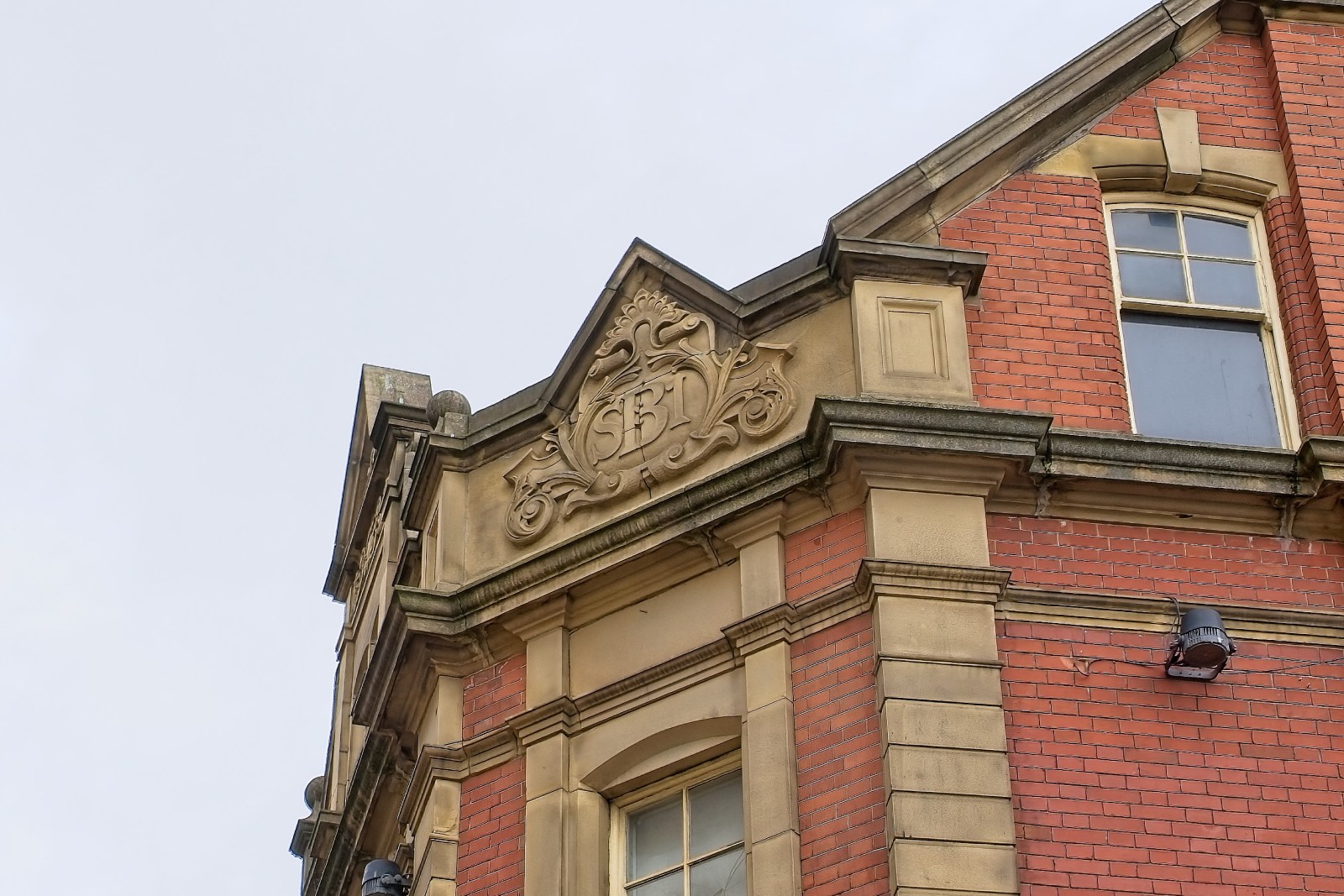
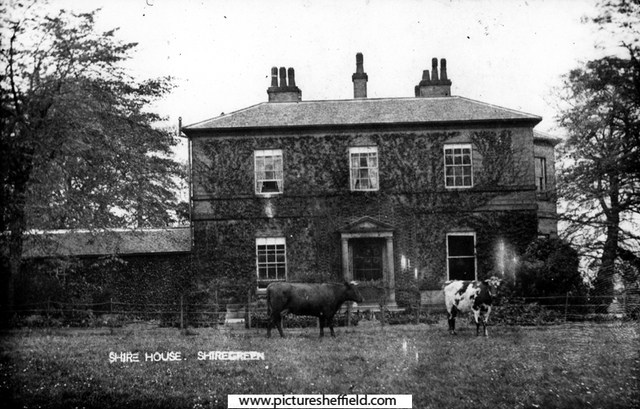
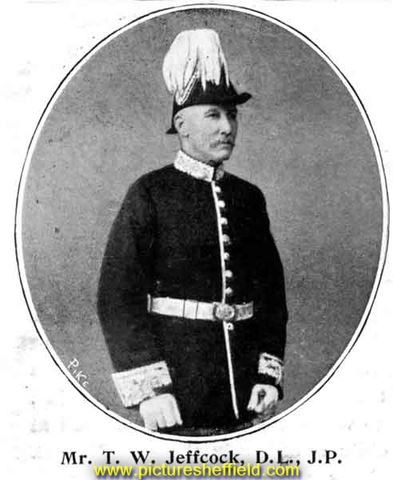
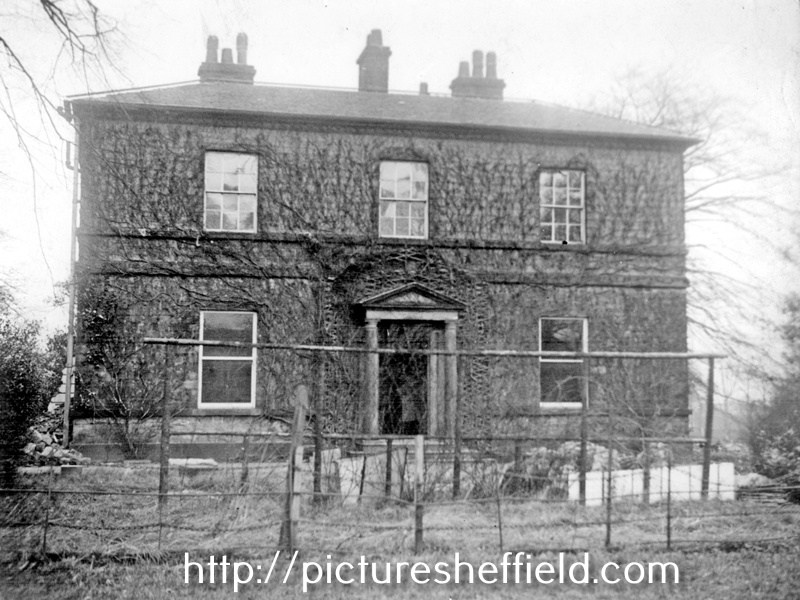
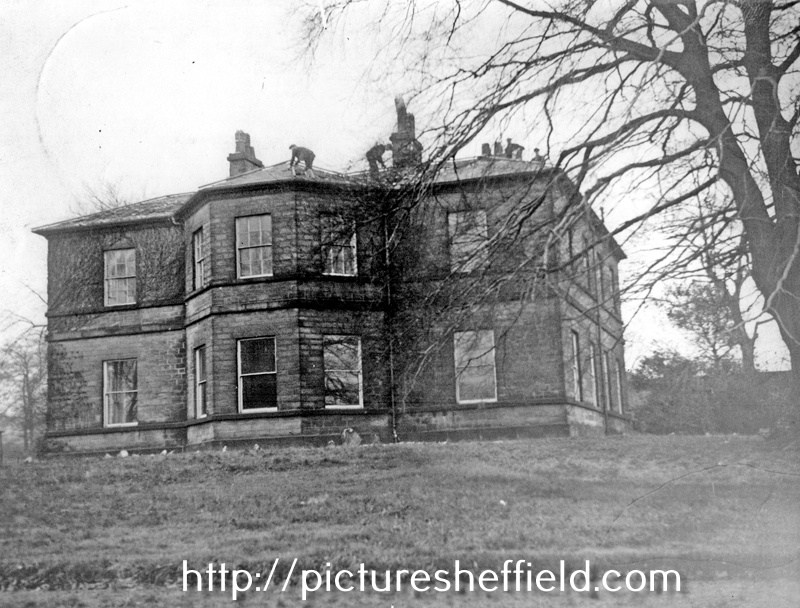
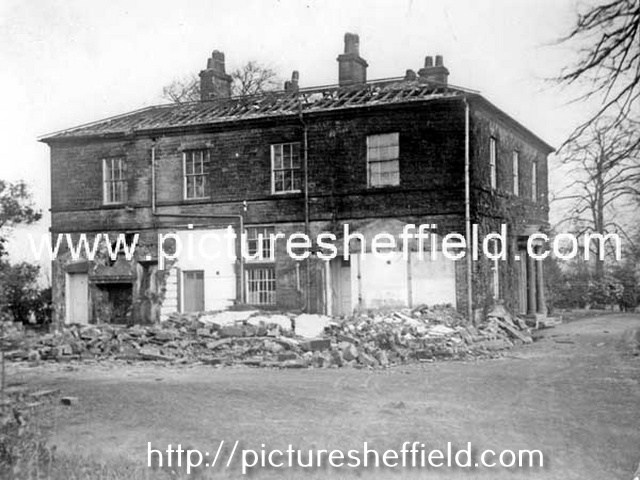
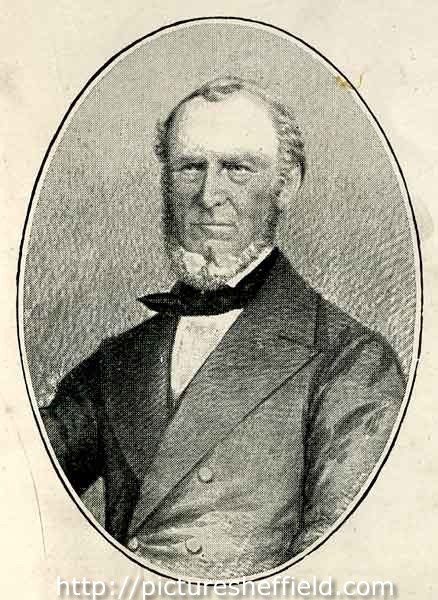
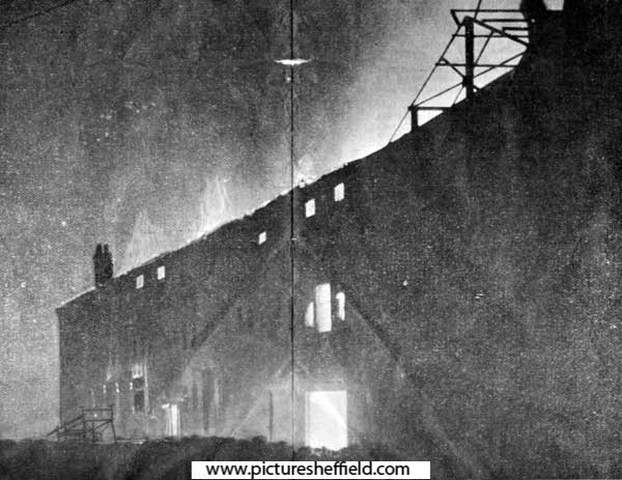
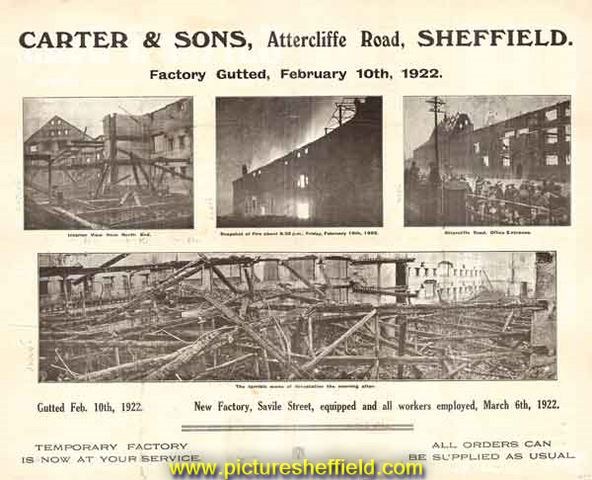
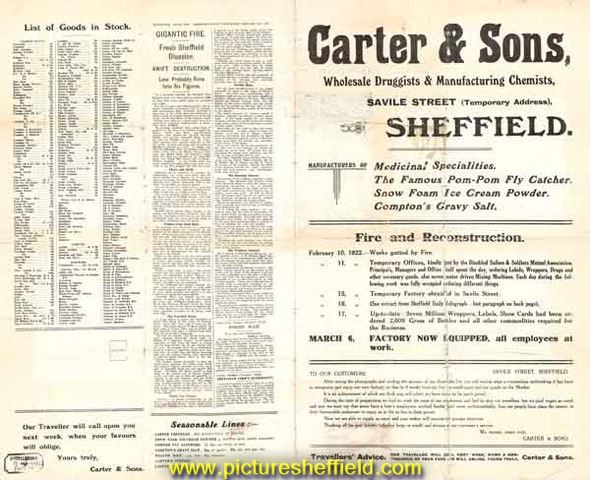
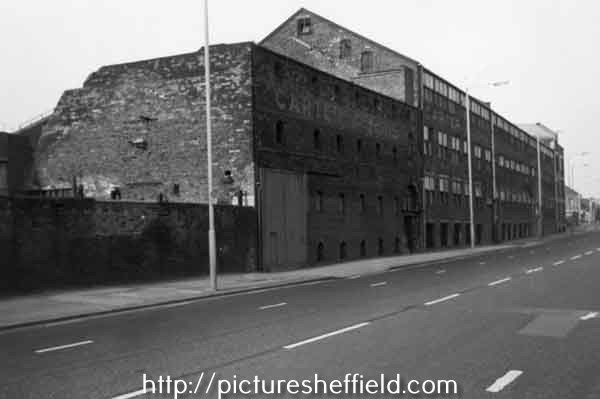
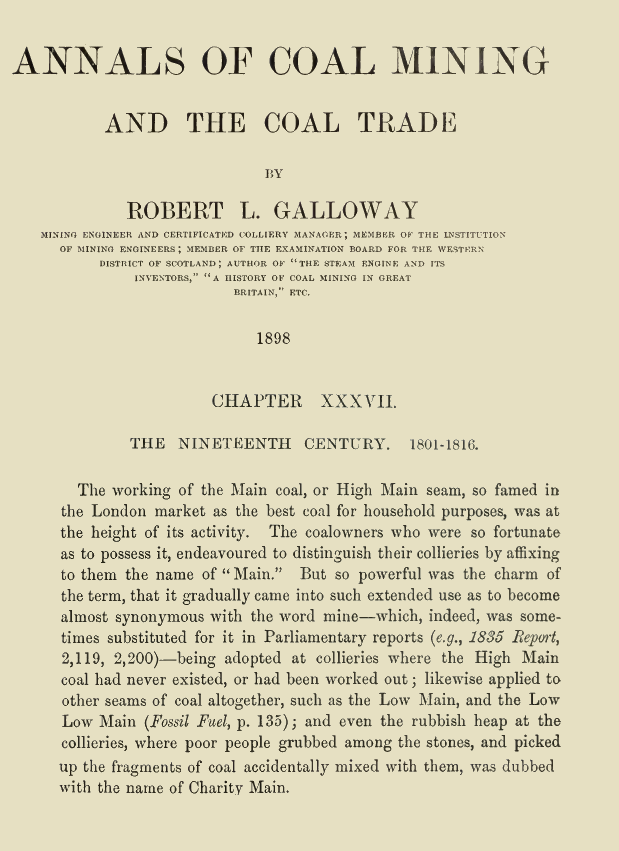
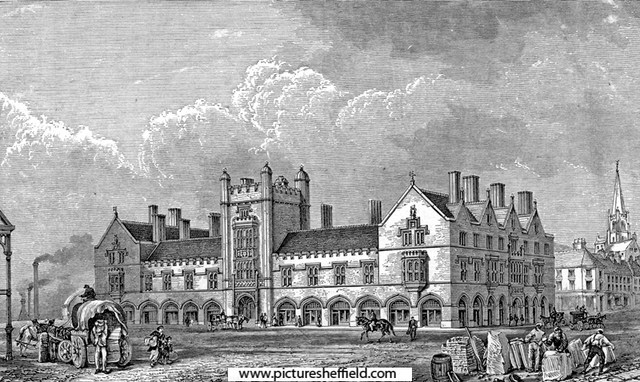
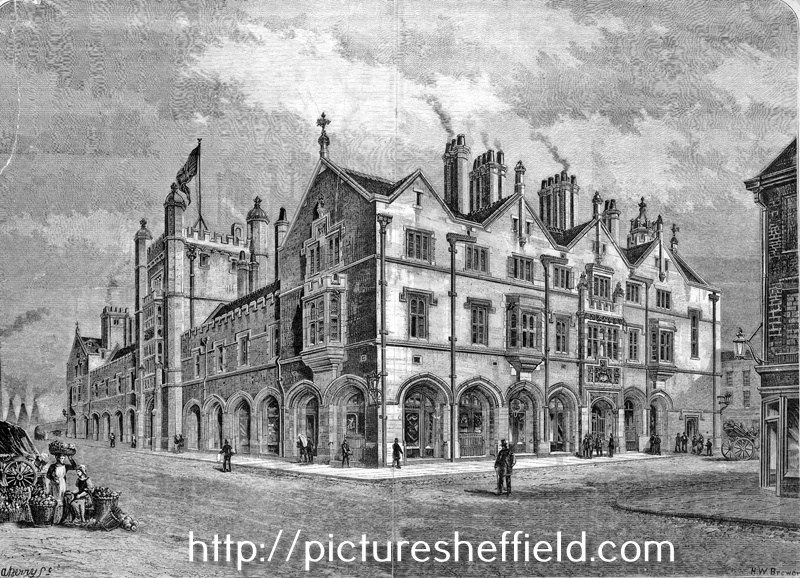
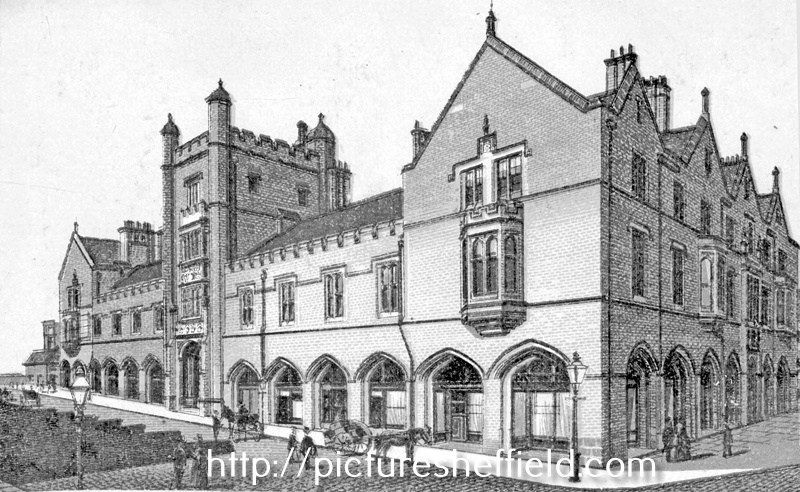
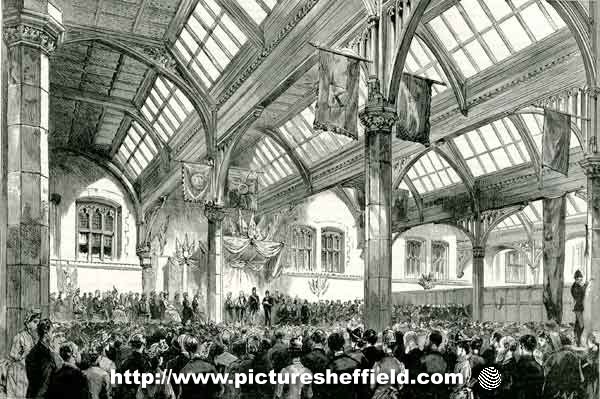
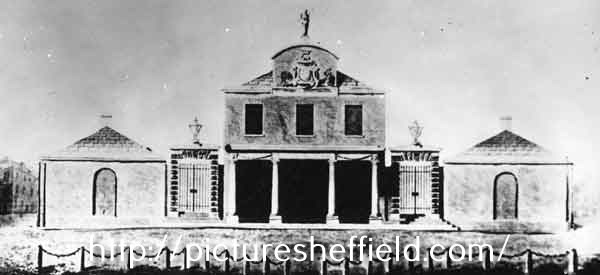
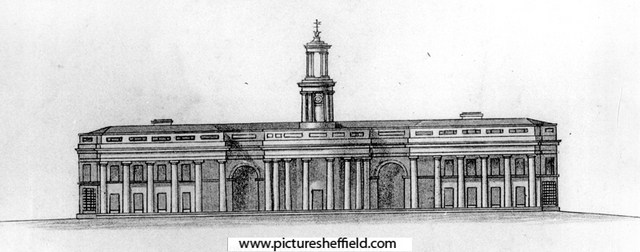
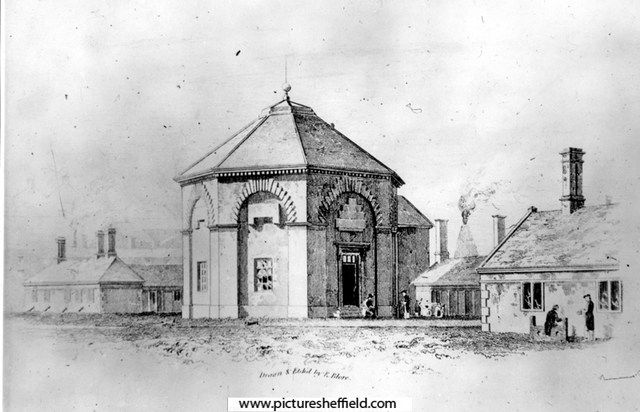
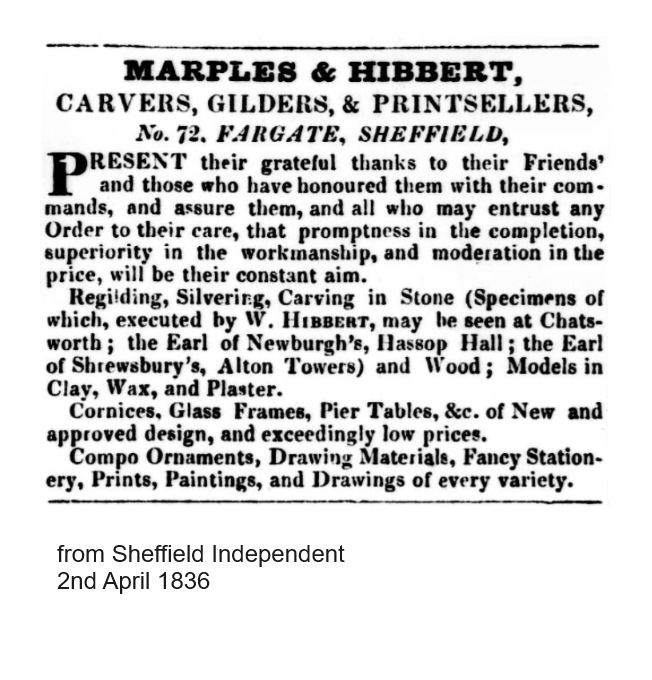

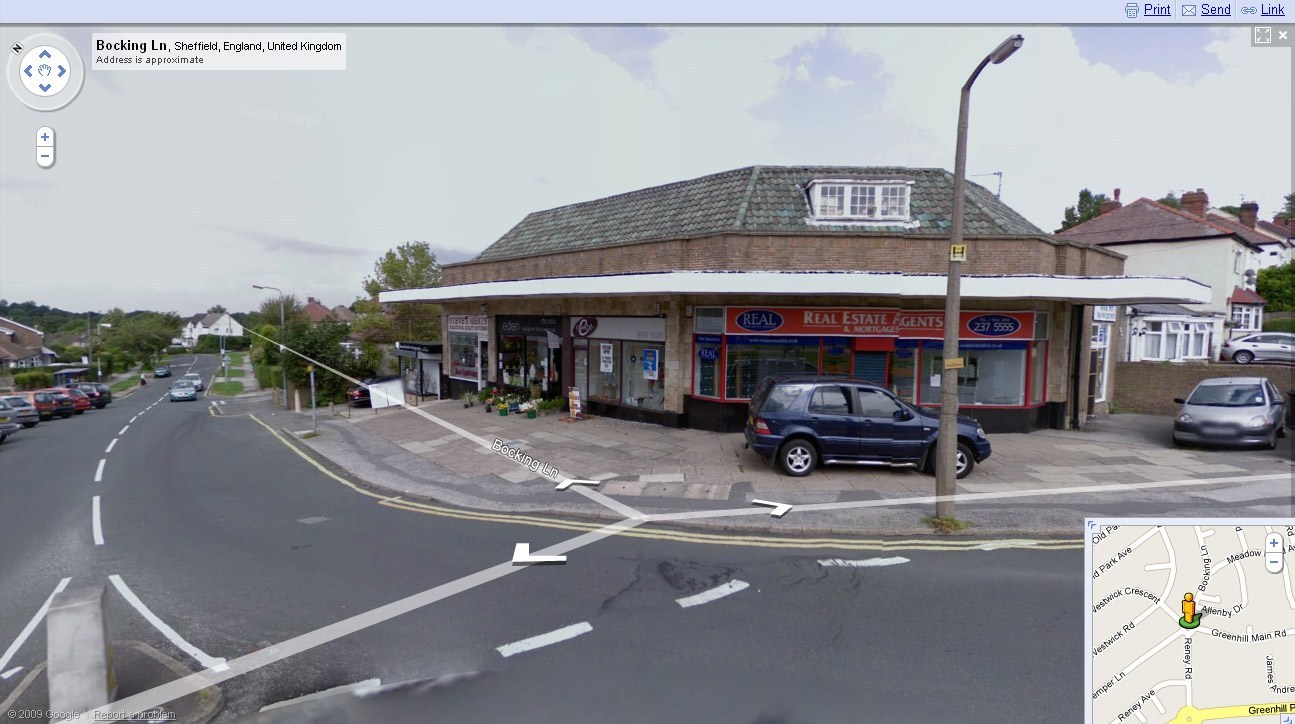
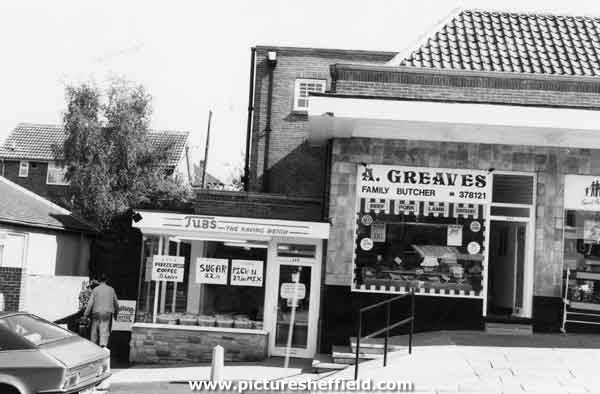
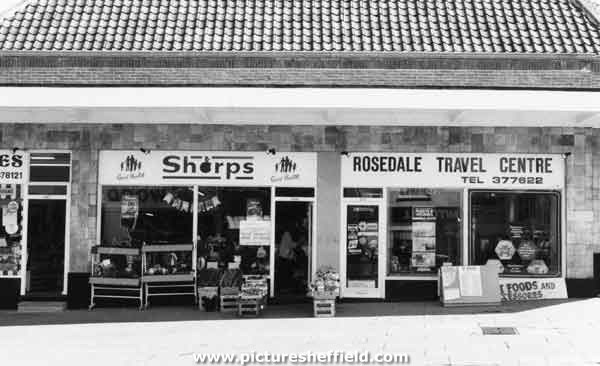
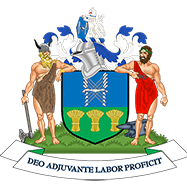
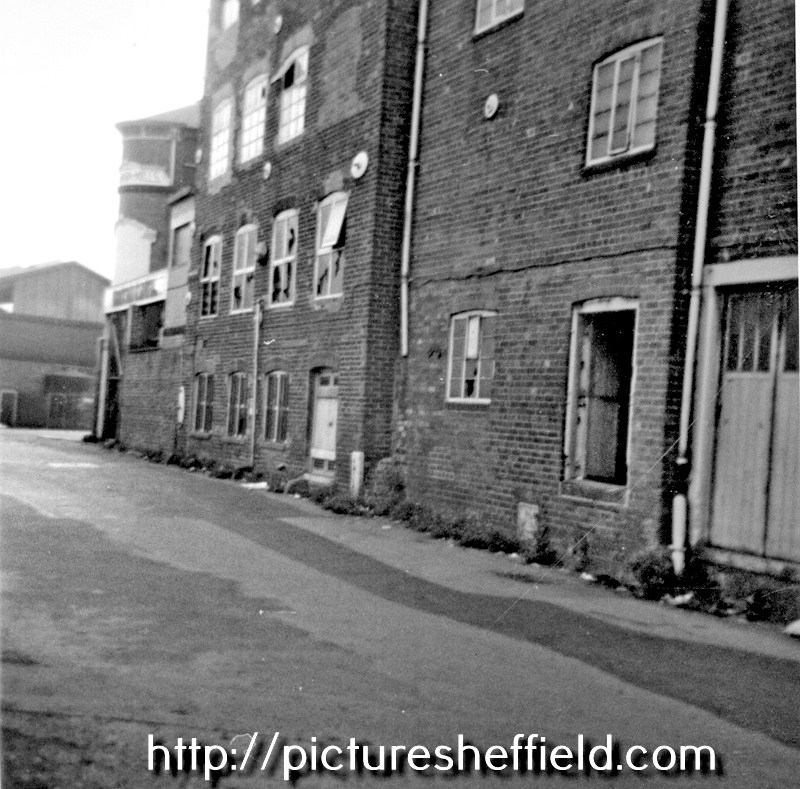
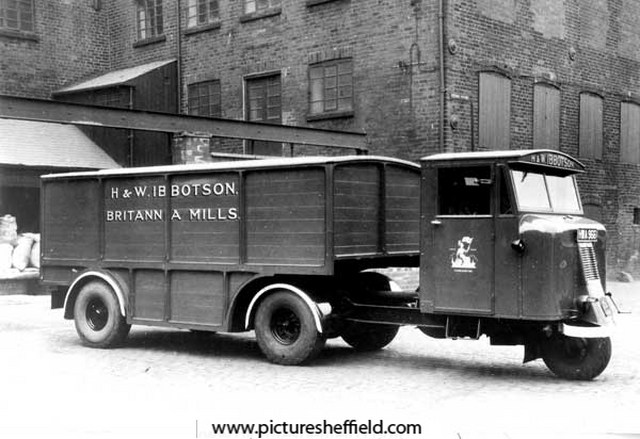
.jpg.6d51ac02997701b3a8ae404e39d22051.jpg)
